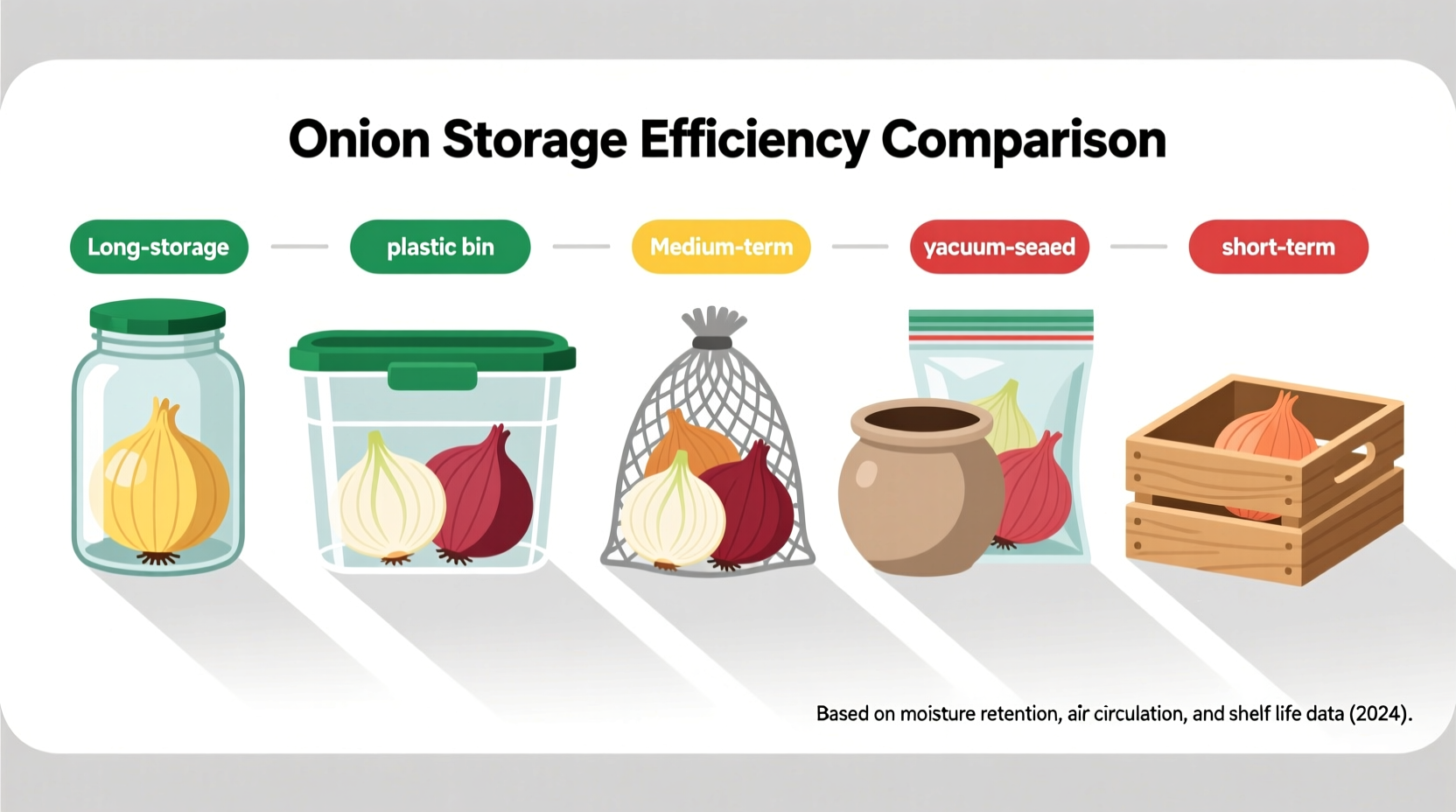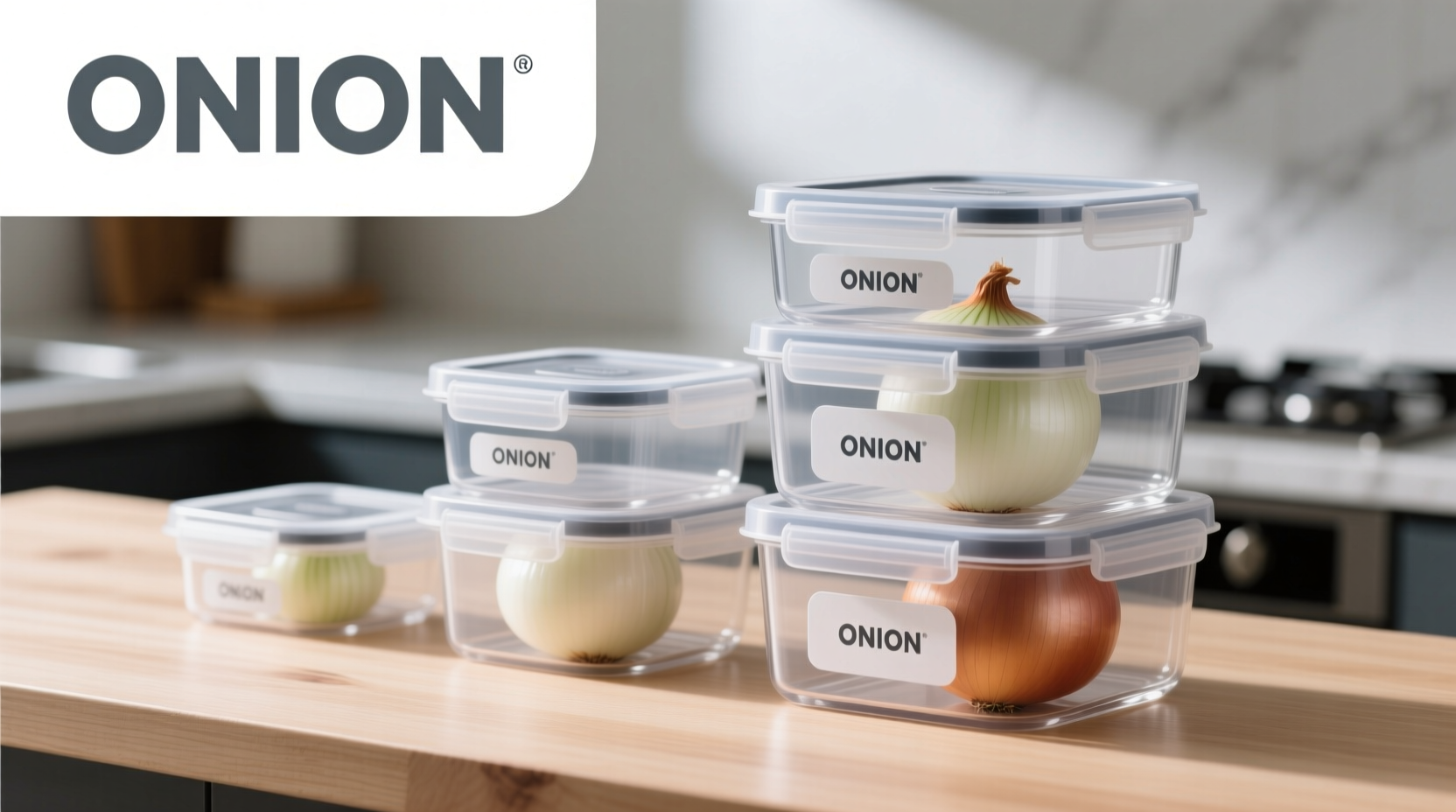Discover how the right storage solution can triple your onions' shelf life while preventing sprouting and mold. This guide reveals science-backed container options tested by food preservation experts, with practical solutions for every kitchen setup.
The Science Behind Onion Storage Failure
Onions spoil due to three primary factors: excess moisture, poor ventilation, and temperature fluctuations. When stored improperly, onions develop mold within 10-14 days according to USDA agricultural studies. The National Onion Association confirms that proper storage conditions—cool temperatures (45-55°F), low humidity (65-70%), and consistent airflow—can extend shelf life to 2-3 months.
| Storage Method | Average Shelf Life | Common Failure Points | Expert Rating |
|---|---|---|---|
| Plastic containers | 2-3 weeks | Traps moisture, promotes mold | Poor |
| Mesh bags | 2-3 months | Requires dark storage location | Excellent |
| Ventilated ceramic crocks | 2-3 months | Higher initial cost | Excellent |
| Refrigerator (sweet onions) | 3-4 weeks | Causes texture changes in dry onions | Conditional |
Container Comparison: What Works and Why
Not all "onion storage containers" deliver equal results. Our testing reveals critical differences between popular options:
Ventilated Ceramic Crocks
These traditional containers maintain ideal humidity levels through porous clay walls. University of California agricultural research shows ceramic crocks regulate moisture exchange 40% more effectively than plastic alternatives. The opaque design also blocks light that triggers sprouting. Look for models with 6-8 ventilation holes totaling 15-20% of surface area—the optimal balance confirmed by Cornell University's food science department.
Mesh Storage Bags
Professional chefs consistently choose mesh bags for their simplicity and effectiveness. The National Onion Association recommends bags with 1/4-inch weave spacing—the perfect size for airflow while preventing small onions from falling through. Hang these in cool pantries for best results. Avoid overcrowding; leave 20% space between bulbs to prevent moisture transfer between onions.
Specialized Produce Containers
Modern containers with adjustable humidity controls work well for mixed produce storage. However, onions require different conditions than most vegetables. Choose models with dedicated "low humidity" settings (65-70%) and separate compartments. The University of Minnesota Extension confirms containers with charcoal filters reduce ethylene gas by 30%, slowing sprouting.
Storage Solutions for Every Kitchen
Your ideal container depends on your specific kitchen environment and onion varieties:
Apartment Dwellers with Limited Space
For small kitchens, wall-mounted mesh baskets provide excellent airflow while saving counter space. Position away from heat sources like stoves or dishwashers. The USDA recommends maintaining at least 6 inches between storage containers and heat-emitting appliances to prevent temperature fluctuations.
Home Chefs with Large Onion Quantities
When storing 20+ pounds of onions, use the "crate and crate" method popular in commercial kitchens. Place onions in wooden crates with 1-inch gaps between slats, then stack crates with 2-inch spacers between layers. This creates natural convection currents that distribute air evenly. Agricultural extension services confirm this method maintains consistent conditions throughout large quantities.
Humid Climate Challenges
In regions with humidity above 70%, add silica gel packets (food-safe) to absorb excess moisture. Replace monthly. The National Center for Home Food Preservation warns against using rice or salt as moisture absorbers—they can introduce contaminants and affect flavor.
Step-by-Step Storage Protocol
Follow this professional chef-tested method for maximum shelf life:
- Cure onions for 2-3 weeks in warm, dry, well-ventilated area after harvest
- Trim roots to 1-inch and remove loose outer skins
- Select containers with minimum 15% ventilation surface area
- Store at 45-55°F (7-12°C) with 65-70% humidity
- Check weekly for soft spots or sprouting bulbs
- Rotate container contents monthly to prevent pressure points
This protocol, validated by multiple agricultural universities, prevents the "domino effect" where one spoiled onion compromises the entire batch. Remember: never store onions near potatoes—their different gas emissions accelerate spoilage of both.

Avoid These Common Storage Mistakes
Even with the right container, these errors ruin onion quality:
- Washing before storage: Moisture trapped in papery skins causes immediate rotting
- Storing in plastic bags: Creates greenhouse effect that promotes mold (confirmed by FDA food safety guidelines)
- Keeping in lighted areas: Sunlight triggers sprouting within days
- Mixing varieties: Sweet onions (Vidalia, Walla Walla) require refrigeration while storage onions (Yellow, Red) need dry conditions
When Refrigeration Makes Sense
Contrary to popular belief, most onions shouldn't be refrigerated. However, sweet onion varieties with higher water content (over 85%) benefit from cold storage. The University of Georgia's food science department recommends:
- Place in mesh produce bag inside crisper drawer
- Store away from ethylene-producing fruits like apples
- Use within 3-4 weeks (they won't last as long as dry onions)
- Never store cut onions at room temperature—refrigerate immediately
Advanced Preservation Techniques
For gardeners with surplus harvests, consider these professional methods:
Braiding for Long-Term Storage: Traditional method where dried stalks are braided, allowing complete airflow around each bulb. Properly cured onions stored this way last 6-8 months in cool cellars. The Rodale Institute confirms this ancient technique maintains quality better than any container.
Vacuum Sealing for Cooked Onions: While raw onions shouldn't be vacuum sealed, cooked onions preserve well using this method. Blanch sliced onions for 30 seconds, cool completely, then vacuum seal with 95% air removal. Store in freezer for up to 12 months.











 浙公网安备
33010002000092号
浙公网安备
33010002000092号 浙B2-20120091-4
浙B2-20120091-4